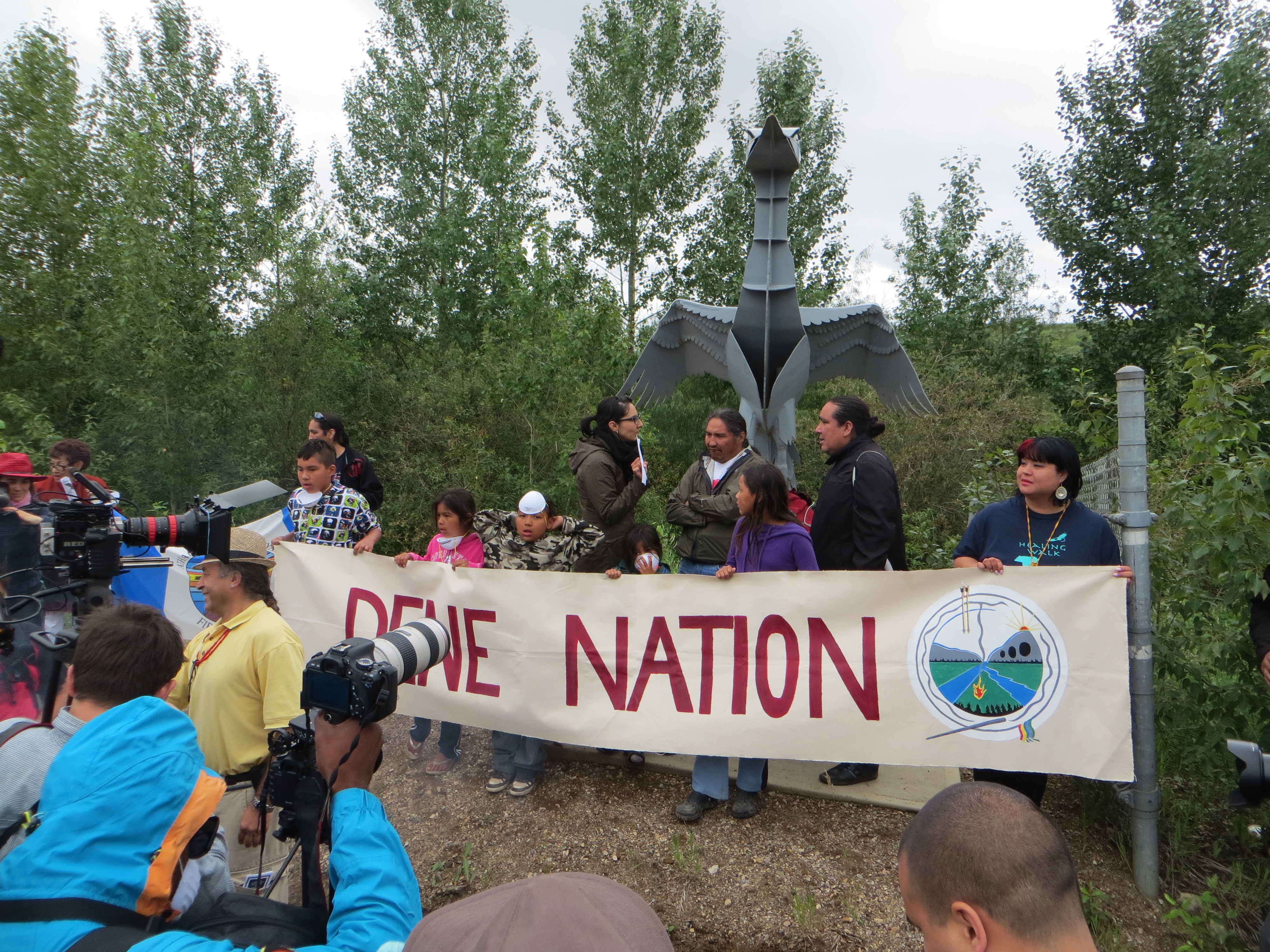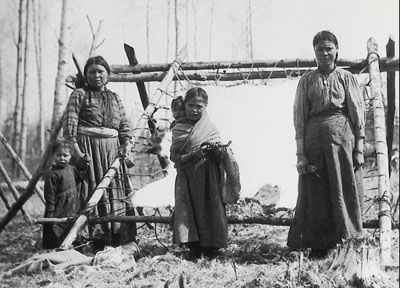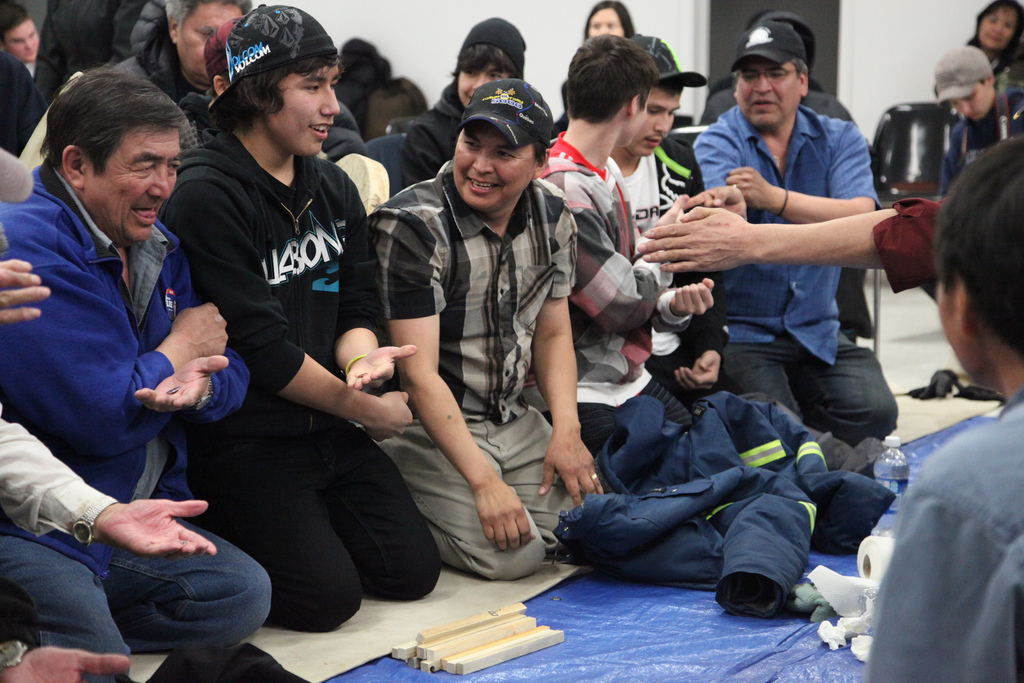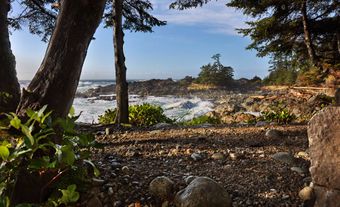Dene Peoples
As part of the largest linguistic group in North America, a number of peoples in Canada identify as Dene. Some of these include:
- Denesoline (also known as Chipewyan)
- Tlicho (Dogrib)
- Dinjii Zhuh (Gwich’in, Kutchin or Loucheux)
- South Slavey (Dehcho, Deh Cho and Deh Gah Got’ine)
- North Slavey (Sahtú), including K’ashot’ine (K’asho Got’ine or Hare/Hareskin), Sahtúot’ine (Bear Lake) and Shuta Got’ine (Mountain)
- Northern and Southern Tutchone
- Dane-zaa (Beaver)
- T’atsaot’ine (Yellowknives)
- Tsuut’ina (Tsuu T’ina or Sarcee)
- Kaska Dena
- Tsek’ehne (Sekani)
- Tsilhqot’in (Chilcotin)
- Dakelh (Carrier)
In the 2016 census, 27,430 people identified as having Dene ancestry.
Traditional Territory
The Dene have historically inhabited central and northwestern Canada in an area known as Denendeh, meaning “the Creator’s Spirit flows through this Land” or “Land of the People.” This region includes the Mackenzie River Valley and the Barren Grounds in the Northwest Territories.
DID YOU KNOW?
In the 2016 census, 825 people claimed Apache ancestry, while another 700 claimed Navajo ancestry. The ancestors of the Apache and Navajo (Tinnë) are said to have originated in northwestern Canada and migrated to the southwestern United States by about 1400 BCE. Like the Dene in Canada, the Apache and Navajo are generally referred to in some literature as the “Athabascans.”
Traditional Life
Dene men hunted caribou — the mainstay of their economy — as well as other game, such as rabbit, deer and moose, in areas around Great Slave Lake, Great Bear Lake and along the Mackenzie River. Fishing supplemented their diet, especially among Dene peoples who lived close to the coast.
Women would often be responsible for cooking meals, gathering food and taking care of children. They made clothes out of natural resources, such as the furs and hides from animals. Sewing tools also came from animals, including bone needles and sinew for thread.
Depending on their geographic location, Dene families lived in tipis, pit houses or lodges. (See alsoArchitectural History: Indigenous Peoples.) They generally travelled often for hunting purposes, either on foot or in canoes, except during the winter when some Dene travelled using snowshoes and toboggans.
Society and Culture
The Dene lived and travelled together with immediate and extended family members. These family clans were self-sufficient, providing one another with food, shelter and education.
During the spring and summer months, Dene family groups often came together to discuss land use and trade, and resolve any intertribal disputes. They also performed cultural ceremonies and celebrations.
The Dene are known for their traditional games, which were originally used to encourage healthy lifestyles, especially among hunters, and to provide entertainment. Dene games are still played today in schools and communities. Many of these games are also official competitions of the Arctic Winter Games.
Religion and Spirituality
Dene oral traditions are records of history, known as þqtú hoghena nüsí hotßü honü, as well as spiritual legends, called üæqhzé. Every Dene nation has its own creation story about how the Earth came to be, and how the Dene people and language were created. All of these tales often feature a Creator who forms the waters and lands of Denendeh. They also feature common characters such as Raven and Yamǫǫ̀zha. Raven is a trickster figure who can transform into different forms. Raven’s behaviours and errors are meant to teach the Dene right from wrong. (See also Raven Symbolism.) Another well-known shape-shifter is Yamǫǫ̀zha (also known as Yamǫ́ria to some people; for others, Yamǫ́ria is a different being). Yamǫǫ̀zha is a medicine man who transforms from human to animal, and helps the Dene solve problems. In some tales, Yamǫǫ̀zha is half-animal/half-human. These legends are significant to Dene culture and spirituality, as they transmit lore and lessons to younger generations. (See also Indigenous Peoples: Religion and Spirituality.)
Language
The Dene language is known as Dene or Na-Dené (also called Athabascan). There are about 28 Athabascan languages spoken in northern Canada, although there are many more spoken in Alaska and in the American southwest. The language is made up of three distinct groups: Pacific Coast Athabascan, Apachean and Northern Athabascan.
In the 2016 census, 13,005 people reported the ability to speak Dene, with the largest concertation of speakers in Saskatchewan (69.7 per cent) and second largest in Alberta (15.3 per cent). With thousands of speakers across parts of Canada and the United States, Dene is one of the biggest language families in North America. However, some Dene languages are considered endangered, such as Danezāgé’ (Kaska Dena ), with 365 speakers recorded in the 2016 census as having knowledge of the language. Wetalh, the language of the Wetal, is considered extinct. In recent years, schools and cultural centres have made efforts to revitalize many of these endangered languages (See also Indigenous Languages in Canada.)
Colonial History
The Dene encountered European traders, explorers and missionaries as early as the 1700s. By the 1900s, the discovery of oil and gold in northern Canada further encouraged white settlement and commercial development in Dene lands. From 1871 to 1921, the Government of Canada signed a series of treaties with various Indigenous peoples as a means of gaining access to lands north and west of Ontario. (See also Numbered Treaties.) This forced many Dene peoples onto reserves and eroded (if not eradicated) traditional ways of life. Other instruments of cultural assimilation, such as residential schools and the Indian Act, also negatively impacted Dene society, economy and ways of life.
Forced Relocation
In the 1950s, about 250 Sayisi Dene were forcibly relocated from their home in Duck Lake, Manitoba to an area near Churchill, partly because the Manitoba government believed they were causing a steep decline in the caribou herd — an idea later proven untrue. In the new location, food was scarce and housing inadequate. The Dene were forced to scavenge the dump and were assaulted by Churchill residents. The forcible relocation caused years of trauma in Dene communities. The federal government formally apologized for the relocation in August 2016.
Rights, Organization and Activism

As a means of protecting and asserting their rights to traditional territories (specifically to the lands of Treaties 8 and 11), self-government and the natural resources on their lands, some Dene nations joined to form the Indian Brotherhood of the Northwest Territories in 1969-70 (renamed the Dene Nation in 1978).
In 1973, Fort Smith Chief François Paulette and other Dene chiefs filed a caveat (a legal warning to third parties), concerning the continued Dene interests in lands of Treaties 8 and 11. While the government maintained that the Dene surrendered their rights to the land by signing the treaty, the Dene argued that their ancestors never intended to do so. After conducting research and reaching out to Dene communities in the Northwest Territories, the presiding judge, Justice W.G. Morrow, determined that the Dene did in fact have rights to the land and its resources. However, the Supreme Court of Canada overturned the case — known as the Paulette caveat — based on a technicality. Nevertheless, Justice Morrow’s findings about Indigenous rights remained valid and led the federal government to accept that further negotiations on the Dene interests were necessary.
In 1976, the Dene Nation released the Dene Declaration and Manifesto. This document called for Dene self-government in the Mackenzie Valley. It was in this area that the proposed Mackenzie Valley Pipeline was to be laid. Incompatibility between the Dene position and that of the federal government regarding rights and title to the lands and resources of the Mackenzie Valley has been an ongoing concern.
Since 1992, however, there have been land claim settlements in Denendeh, some of which include the Gwich’in (1992), Sahtu (1994) and Tlicho (2003). (See also Indigenous Land Claims and Indigenous Peoples: Treaties.)
Contemporary Life
Dene First Nations across Canada have been actively engaged in programs concerning Indigenous health, education, community development, and land and resource issues. As a community, they have reached some important milestones. For example, in 1990, Dene languages become official languages of the Northwest Territories. On 1 September 2016, the Délįnę Got’įnę Government achieved the right to self-government.

 Share on Facebook
Share on Facebook Share on X
Share on X Share by Email
Share by Email Share on Google Classroom
Share on Google Classroom









